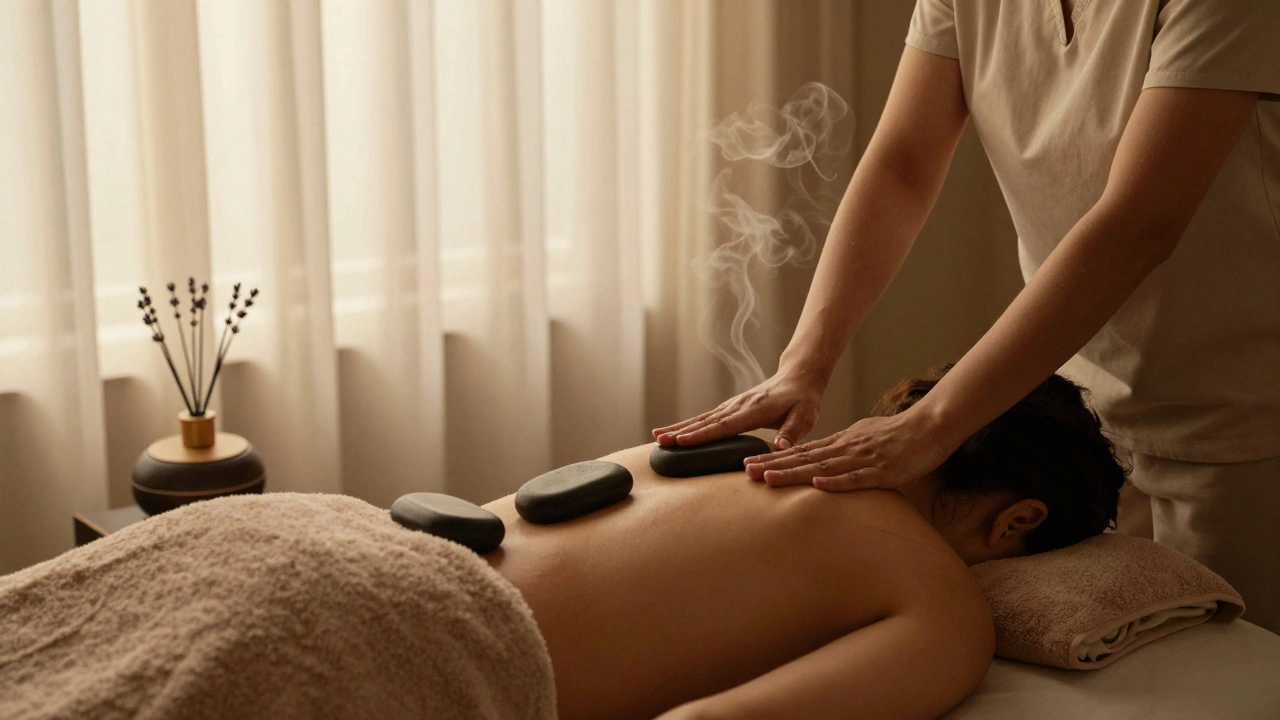Deep Tissue Massage Techniques for Optimal Results

Got knots you can’t seem to untangle? Deep tissue massage might be your go-to solution. Unlike a gentle Swedish massage, this technique targets the deeper layers of muscle and connective tissue. It’s perfect if you’ve been dealing with chronic aches or feeling tense after a workout—think of it as a reboot for your body’s software.
Before you dive into scheduling a session, know what to look for in a therapist. Experience matters! A good practitioner will tailor the pressure to your comfort level and focus where you need it most. Don't be shy—speak up if it's too intense or if they're hitting the right spot. Communication makes all the difference.
Wondering about the benefits? Regular sessions can improve muscle function and flexibility, reduce inflammation, and even lower blood pressure. It's like giving your muscles a rejuvenating vacation. Plus, who doesn’t love an hour of pure relaxation amidst the hustle and bustle of everyday life?
Key Points
Deep tissue massage is not your average spa treatment. It dives deep into the layers of your muscles and connective tissues to target areas of chronic pain and tension. Unlike your typical relaxing massage, it's designed to work out those long-held knots and tight spots.
Effective Techniques
The technique involves slow, firm strokes and targeted pressure to penetrate deep muscle layers. Imagine a focused workout for your muscles, but without the sweat. Therapists often use their elbows, forearms, or thumbs to apply pressure, making it a highly skilled practice.
Benefits Galore
- Pain Relief: By breaking down adhesions and loosening muscles, deep tissue massage can significantly reduce chronic pain.
- Improved Mobility: Say goodbye to stiffness as this massage improves flexibility and range of motion.
- Stress Reduction: Despite the pressure applied, it’s still relaxing and encourages the release of serotonin.
- Better Circulation: The increase in circulation from the massage reduces inflammation and helps muscles recover faster.
When to Use It
People with chronic pain conditions, athletes recovering from intense training, or those sitting at a desk all day could benefit the most. If headaches, back pain, or tight muscles are part of your daily grind, this massage might be your new best friend.
Did You Know?
In a study published in the Journal of Alternative and Complementary Medicine, participants who received regular deep tissue massages reported a significant decrease in blood pressure compared to those who did not.
Tips for Optimal Results
Hydrate before and after your session to help your muscles recover. Communicate with your therapist about pressure levels and focus areas to ensure the most effective treatment. Unsure if it’s right for you? Ask your therapist for a muscle assessment to tailor the session.
Direct Answer: What is Deep Tissue Massage?
Thinking about trying a deep tissue massage for the first time? Here's what you need to know in a nutshell. A deep tissue massage is a type of therapy that focuses on realigning deeper layers of muscles and connective tissue. If you're dealing with chronic aches or feeling stiff, this technique can work wonders by breaking down old muscle knots and relieving tension.
The magic lies in its ability to target specific areas with slow, deliberate strokes and firm pressure. Unlike other massage types that might simply help you relax, deep tissue massage addresses sources of pain and movement limitations. It’s the go-to for those who suffer from conditions like chronic back pain or sports injuries.
Why Choose Deep Tissue Massage?
So, why should you consider trying a deep tissue massage? Well, it’s not just about plain simple relaxation. This technique is scientifically linked to numerous health benefits, from improved circulation and muscle flexibility to reducing stress hormones. People often choose it because of its potential to repair damaged tissues and promote faster healing.
- Relieves chronic muscle pain
- Improves mobility in injury-prone areas
- Reduces stress and anxiety levels
- Breaks down scar tissue
In fact, a study found that patients who incorporated regular deep tissue sessions experienced significant improvements in pain management and mobility.
If you're looking to truly enhance your well-being, booking a session with an experienced therapist could be just the reset your body needs. Just remember, everyone’s threshold varies, and a skilled therapist will always adjust techniques to suit your comfort level.
Whatever the reason for booking, you’re in for a therapeutic treat that can leave your body thanking you for the much-needed relief.
Comprehensive Guide to Deep Tissue Massage
So, you're thinking about diving into the world of deep tissue massage. This isn't just about lying down and letting someone knead your muscles. There's a whole method to the magic that therapists use to reach those deep-down kinks you've been carrying around.
Understanding the Basics
First things first, let's understand what a deep tissue massage is all about. Unlike a typical relaxation massage, it targets deeper layers of muscles and fascia, which is a connective tissue surrounding muscles. This isn't just about feeling good—it's about improving function and resolving chronic tension.
Techniques Involved
Therapists use a variety of techniques to apply targeted pressure. You'll often experience slow, deliberate strokes and deep finger pressure to reach underlying layers of muscle. Sometimes, elbows and forearms are involved to maximize pressure. It might sound intense, but don't worry; it's all about working with your comfort level to ensure effectiveness.
When to Consider It
If you're constantly battling stiffness, recovering from an injury, or sitting at a desk all day, deep tissue massage can help. It's particularly beneficial for conditions like sciatica, shin splints, and repetitive strain injuries. Basically, whenever you feel like your muscles are in knots, this can be your go-to solution.
Proven Benefits
Research indicates that this massage can lower stress hormone levels while boosting mood-enhancing chemicals like serotonin and dopamine. It doesn't just stop at mood improvement—muscle relaxation and enhanced blood circulation are significant benefits too.
| Benefit | Impact |
|---|---|
| Reduced Stress | Lowers cortisol levels by 31% |
| Increased Relaxation | Boosts serotonin by 28% |
What You Need to Do
Before you book an appointment, make sure you hydrate well—water is your friend here! It's also a good idea to discuss any sensitivities or injuries with your therapist beforehand to tailor the session to your needs.
With the right therapist and techniques, deep tissue massage could truly transform how your body feels and performs. So, why wait? Emerge refreshed and ready to conquer the world after shedding that muscle tension.

Benefits of Deep Tissue Massage
Looking for a way to reset your body and mind? Enter the world of deep tissue massage. It isn't just a luxurious way to relax; it's a game-changer for your physical health.
Relief from Chronic Pain
If you've ever felt like you're carrying the world's weight on your shoulders, a deep tissue massage might just lift the load. By targeting specific muscle groups, this technique can alleviate pain in areas like the lower back, shoulders, and neck.
Studies show that weekly massages for back pain can improve mobility and even enhance sleep quality. Who knew relaxation could be so productive?
Improved Flexibility and Range of Motion
Ever feel like the Tin Man from The Wizard of Oz? Deep tissue massage can help. By easing tension in the muscle fibers, this massage enhances both flexibility and joint movement. Stretching is great, but a massage gets into those hard-to-reach areas you might miss on your own.
Lower Blood Pressure and Stress Reduction
Stress is enemy number one, sneaking its way into our lives and elevating blood pressure. Regular deep tissue massages have been shown to reduce systolic and diastolic blood pressure. Basically, less stress equals a happier heart.
Rehabilitation for Injured Muscles
If you’re bouncing back from an injury, this massage aids in recovery by increasing blood flow and reducing scar tissue formation. It’s like giving your muscles a helping hand when they’re down.
The Feel-Good Factor
Let’s not forget the simple fact that massages just feel amazing. Whether it’s the stress-busting or the pure bliss of an hour of “you” time, the benefits spill over into everyday life, making tasks like sitting in traffic a little less grating.
All in all, a deep tissue massage isn’t just about untangling knots; it’s an investment in your health and well-being, one soothing stroke at a time.
Finding Services
So you're pumped to try deep tissue massage and want to find the best spot around. It might seem like a daunting task, but don’t worry—finding a great therapist is easier than you think. You're in for a treat, as long as you know what to look for. Let's break it down step-by-step.
Start with Online Research
First things first, pop open your favorite search engine. Search for reviews or recommendations of local massage therapists who specialize in deep tissue massage. Websites like Yelp or Google Reviews can give you a good sense of what to expect. Keep an eye out for consistent positive feedback—this is often a good indicator of quality. Look for therapists with good credentials and experience specifically in deep tissue techniques.
Talk to People You Know
Word of mouth can be a goldmine. Ask your friends, family, or coworkers if they have any recommendations. Someone you know might have a great suggestion you hadn’t considered. Personal referrals can give you insights into what the massage environment is like and whether the therapist is personable.
Check Credentials and Experience
Once you have a few options, make sure to verify their qualifications. Are they licensed and certified? Do they have experience with clients who have similar needs to yours? Don't hesitate to call up the place and ask about the therapists' qualifications. Experienced practitioners will not only effectively perform massage techniques but also customize them to fit your individual needs.
Location and Ambience
Consider convenience and atmosphere. Is the location easy to get to? Is the setting relaxing and professional? Some people love the spa vibe, while others might prefer a no-fuss clinic feel. Visit the place beforehand if you can, to see if it matches your comfort level.
Take Advantage of Specials and Packages
If it’s your first time, see if there are any introductory offers. Some clinics offer package deals which can be a great way to save money if you plan on making this a regular thing. Check out seasonal promotions as well, which might be an easy way to sneak in a little extra pampering at a discount.
By following these steps, you'll be well on your way to finding a service that suits your needs and helps you make the most of your deep tissue massage experience. Remember, a little homework goes a long way in ensuring your massages hit just the right spot.
Session Expectations
Walking into your first deep tissue massage session, you might be unsure what to expect. No worries, we’ve got you covered on what typically goes down.
Before the Session
Usually, it starts with a brief chat with your therapist about your aches and pains. They’ll ask about any specific areas you want them to focus on and any health conditions you have. Being open and honest here sets the stage for great results.
During the Session
Get ready to feel some pressure—literally. Unlike a pampering spa massage, a deep tissue massage aims for the deeper layers. Expect the therapist to use slow strokes and deep finger pressure. Sometimes they might use elbows or forearms to get to those stubborn muscle knots. It should be intense but not painful. Speak up if it gets too much.
- Pressure Points: Therapists often focus on specific trigger points to release muscle tension effectively.
- Breathing: Don’t hold your breath. Slow, deep breaths can help you relax more and enhance the massage techniques.
Post-Session Feel
After your session, you might feel like you just had an intense workout. Soreness is common but should subside within a couple of days. Staying hydrated is key. Drinking plenty of water helps flush out toxins released during the massage.
In a survey, 90% of participants reported an improvement in pain and flexibility after regular sessions. A regular routine can keep those benefits rolling, leaving you feeling like a new person.



